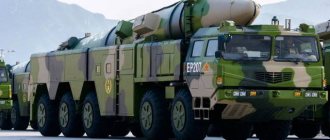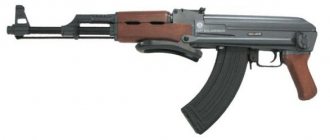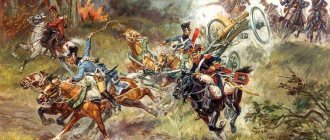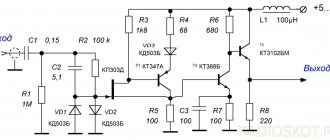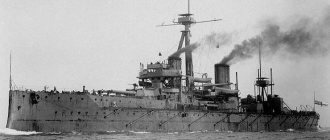Declaration and essence of the program
The launch of the long-term program Strategic Defense Initiative (SDI) was announced by R. Reagan on March 23, 1983. The program was positioned as research and scientific-technical. Its main component was to be a powerful missile defense system, partially based in space, capable of delivering “space-to-ground” and “ground-to-space” strikes. The development of fundamentally new types of weapons was planned specifically for the program.
Officially, the implementation of the program was supposed to provide the American continent, and primarily the United States, with guarantees against an atomic attack by Soviet ballistic missiles. The new weapon had to be capable of intercepting and shooting down them at any part of the trajectory.
However, the word “defense” in the name of the program was used solely to disguise the true intentions, and in the United States they did not even particularly try to hide this. The implementation of SDI was supposed to provide the United States with unambiguous military superiority over the USSR, victory in the Cold War and transformation into the only undisputed leader of the unipolar world. The program was long-term, and its curtailment in 1993 was largely due to the fact that the goals set at that time could be considered achieved (due to the collapse of the USSR and the economic crisis in Russia), and such expensive measures were no longer required.
Pentagon's space ambitions
The need for a balance of power in space became obvious back in the early 1960s, when space powers began to deploy reconnaissance and communications systems in the outer reaches of space. And not always for peaceful purposes, so the fight against spaceships and satellites of a potential enemy became an urgent necessity, and the USSR began to develop anti-satellite weapons.
In the USA, such work was launched even earlier. The first allocations for these purposes were allocated in 1957, when Moscow and Washington were just preparing to launch artificial Earth satellites into orbit. And in 1959, the Bald Orion rocket, launched from the B-47 Stratojet medium bomber, had already launched towards the target satellite. Three years later, the F-4 Phantom fighter-bomber was tested as a carrier. However, faced with technical problems, the Pentagon chose to abandon the Bald Orion program, but not the idea of shooting down satellites in space.
© af.mil
A Boeing B-47 Stratojet bomber takes off with a Bold Orion missile on board.
In 1963-1964, the Americans simultaneously deployed two ground-based anti-satellite systems. On Kwajalein Atoll in the Pacific Ocean, under the patronage of the US Army, an anti-satellite weapon complex was built (program “505”), the warhead of which was a modified Nike Zeus anti-missile missile, and exactly a year later an anti-satellite complex appeared on Johnston Atoll (also in the Pacific Ocean). based on medium-range missiles "Thor" (program "437"). However, the set goals were not achieved, and in 1967 the “505” program ceased to exist due to “technical imperfections”. The Americans tinkered with the “437” program a little longer, hoping to increase the target interception altitude of the “Thor” missile and equip it with a non-nuclear warhead, but even here success was not achieved.
In 1976, with the advent of new technologies, the George Ford administration ordered the acceleration of the creation of a new complex of anti-satellite weapons, called ASAT. And in 1985, after the Soviet Union had made a unilateral commitment not to launch weapons into space, an American Sram-Altair missile hit a target satellite in space.
Under the fuselage of the F-15 fighter, which took off from a US air force base in California, there was a two-stage missile with a miniature homing aircraft. It was this “product” that struck the American Solund satellite. The interceptor projectile had several dozen small engines, an infrared guidance system and an orientation system based on a laser gyroscope, as well as a mini-computer. Targeting was carried out using the thermal radiation of the satellite.
© catalog.archives.gov
An F-15 Eagle fires an ASM-135 ASAT anti-satellite missile during a test September 13, 1985, at the Pacific Missile Range Range.
The Pentagon's plans called for the deployment of 56 F-15 carrier aircraft and 112 missiles at Langley Air Force Base (Virginia) and McChord Air Force Base (Washington) over several years.
At the same time, the most ardent supporters of Star Wars planned the construction of anti-satellite bases in the Falklands, Australia, the Ascension and Diego Garcia islands and the creation of floating bases - in the case of equipping carrier-based F-14 Tokmet multi-role fighters with ACAT missiles. And a number of American laboratories were commissioned to develop laser space weapons. According to one of the projects, it was planned to deploy 15 maneuvering platforms with laser systems in space.
The Western press reacted differently to US military programs in space: some admired the achievements of the Americans, others feared the expansion of the arms race in outer space. Here, for example, is a CBS report from that time period: “The Reagan administration tested an anti-satellite weapon, which Moscow branded an open provocation. The USSR warned that in the event of a test of American anti-satellite weapons, it would consider itself free from the obligation not to deploy its own similar system.”
The message turned out to be not exactly prophetic... Firstly, by that time the USSR already possessed technologies that allowed it to give the Americans a worthy answer. Secondly, the Soviet Union has been aware of the Pentagon’s space ambitions since the early 1960s.
Components of the SOI program
As part of the implementation of the program, in addition to relatively conventional (at that time) types of weapons designed to detect and prevent a nuclear strike, it was proposed to develop almost fantastic designs:
- lasers pumped by a nuclear explosion;
- chemical lasers for deployment in space;
- orbital mirror systems (which were supposed to redirect rays sent from Earth);
- special atomic shells with tungsten buckshot;
- neutral particle emitters (so-called beam weapons) to destroy electronics and identify false targets;
- interceptor satellites;
- rail accelerators for accelerating anti-missile projectiles to super speeds.
The greatest concern was the question of the ability of designers to guarantee all these miracles of technology from spontaneous operation or incorrect reaction. At the time of the launch of SDI, it was already well known that automatic threat recognition systems based on artificial intelligence sometimes tend to mistake the most innocent manipulations of a potential enemy as a sign of an approaching attack. Also, such complex systems themselves could theoretically work involuntarily, which the other side would rightfully consider an attack.
Program participants and project price
Initially, the United States developed SDI independently, but then some NATO countries joined the program. Great Britain showed the greatest activity.
The Strategic Defense Initiative was a very expensive project. In the final year of 1993 alone, more than 4.3 billion dollars were spent. The high cost also could not but affect the decision in favor of terminating the project. In the United States, dozens of industrial and research giants received contracts for large sums within the framework of SDI.
Since 2001, some components of SDI have returned to the plans of the US military. However, the scale of these developments cannot be compared with the original program.
Counteraction to SDI by the USSR and the Warsaw Pact Organization
The USSR was outraged by the “star wars” program, rightly considering it hostile to the internal affairs department and dangerous for the whole world. However, a similar Soviet program was not followed - the country’s leadership decided to react “asymmetrically”. Perhaps the reason was the crisis that had already hit the Soviet economy at that time.
The plan for an “asymmetric response” to SDI involved not so much the creation of new weapons as the improvement of old ones.
- It was supposed to improve and strengthen the camouflage of nuclear facilities and vehicles, to make missile silos and launchers as resistant to enemy attacks as possible.
- The task was to increase the maneuverability of Soviet missiles and their speed in the most vulnerable sections of the trajectory.
- It was also planned to develop methods to neutralize the impact of potential enemy weapons and destroy them.
Not all measures proposed by this concept were implemented. This was partly due to the crisis in the USSR, partly due to the variability of the SDI components themselves.
New heroes
In 1975, George Lucas found himself at a crossroads. His friend and mentor Francis Ford Coppola achieved great success in Hollywood (with The Godfather) and was able to secure financing for Apocalypse Now, an anti-war drama with a Vietnam theme. Lucas was supposed to direct the film. Apocalypse Now promised to be his first box office masterpiece, as psychological and dark as Scorsese's Taxi Driver or Polanski's Chinatown. But Lucas had been preparing another project for several years and refused Coppola's offer. As a result, he took on Apocalypse himself, and Lucas took on Star Wars.
According to him, "Star Wars" was intended to express the same ideas as the Vietnam war drama - only in the setting of a galaxy far, far away. Lucas conceived a story about the victory of the rebel aborigines over the aggressor. In drafts of the script, written at the height of the Watergate scandal, Palpatine is directly based on Richard Nixon, and the empire operates like the US army in Vietnam. These parallels are especially obvious in Return of the Jedi, where there is a Viet Cong - the Ewoks, and a technologically advanced empire is defeated by a "primitive" people.
But Lucas also set himself another goal - to return to the big screen the aesthetics of the blockbusters of his youth, films about pirates, cowboys, brave warriors and space heroes (Flash Gordon), optimistic and morally unambiguous films with “good” and “bad” guys . Oddly enough, by the 1970s such films had gone out of fashion - they were not filmed in Hollywood and were not shown in cinemas.
Lucas solved this problem much more successfully than the anti-war and anti-imperial ones. Aesthetics won over the idea. Star Wars hit the bull's eye: America had suffered enough of an identity crisis in 1977. The assassination of John F. Kennedy, the curtailment of the ambitious Great Society reform program, the resignation of the president due to the Watergate scandal, the inglorious war in Vietnam, from which the United States had to leave, and with a feeling of internal wrongness - and on top of that, stagflation (rising prices plus economic depression ). If anyone else in the world saw the United States as a savior of the world and a defender of democracy, few inside the country believed this.
And then a simple and spectacular film about the victory of the “good guys” over a tyrannical state comes out. Lucas's critical intent now seems naive: why on earth would the viewer identify (the US) with the villains? On the contrary, Luke Skywalker, Han Solo, Princess Leia are ready-made role models of the American hero. He fights Tusken Indians and walks through taverns in the Wild West (Tatooine), wins races and escapes bandits like Han Solo, or leads the war for independence like Senator Leia or the wealthy planter George Washington.
Luke Skywalker and Han Solo receive medals
The space fighter battles and bomber runs towards the target at the end of the film are an obvious reference to World War II, the last war in which America was clearly on the side of good - and won. Star Wars doesn't just take viewers into a world of amazing space adventures - the film shows that war can be an exciting and noble endeavor. And this is even if we take into account the final scene, where Luke and Han Solo are solemnly awarded medals before the formation!



